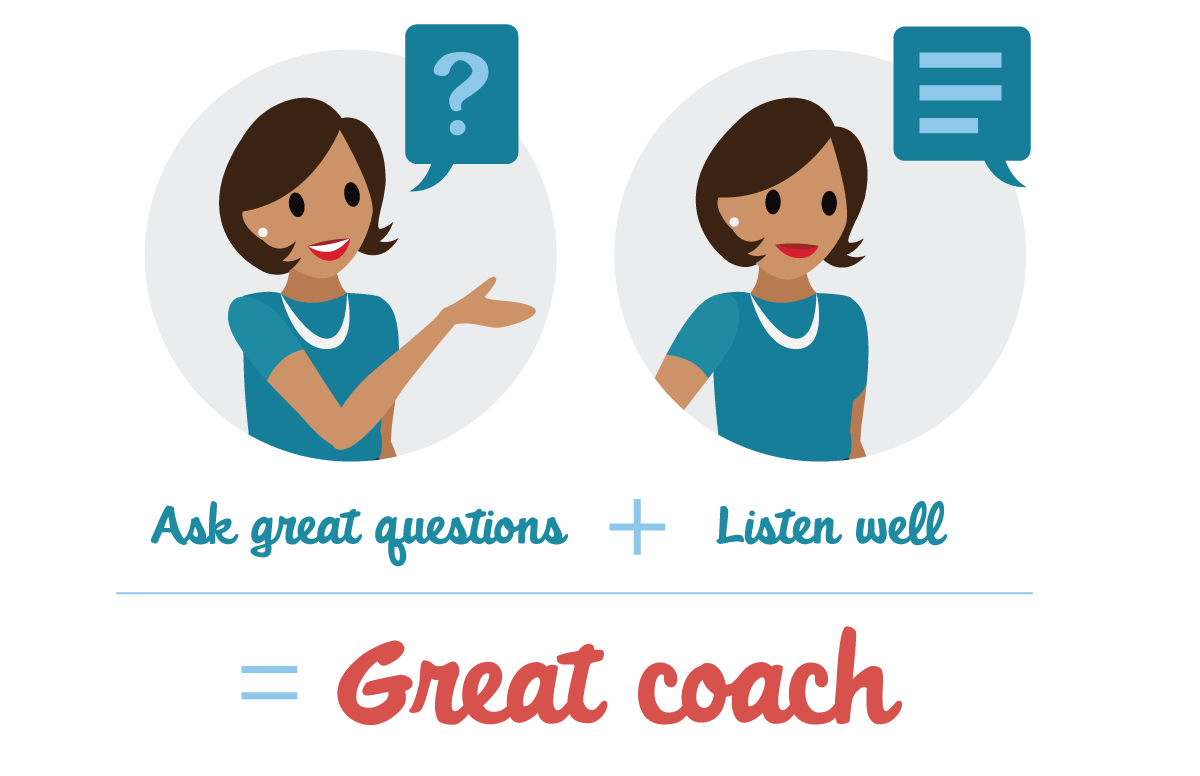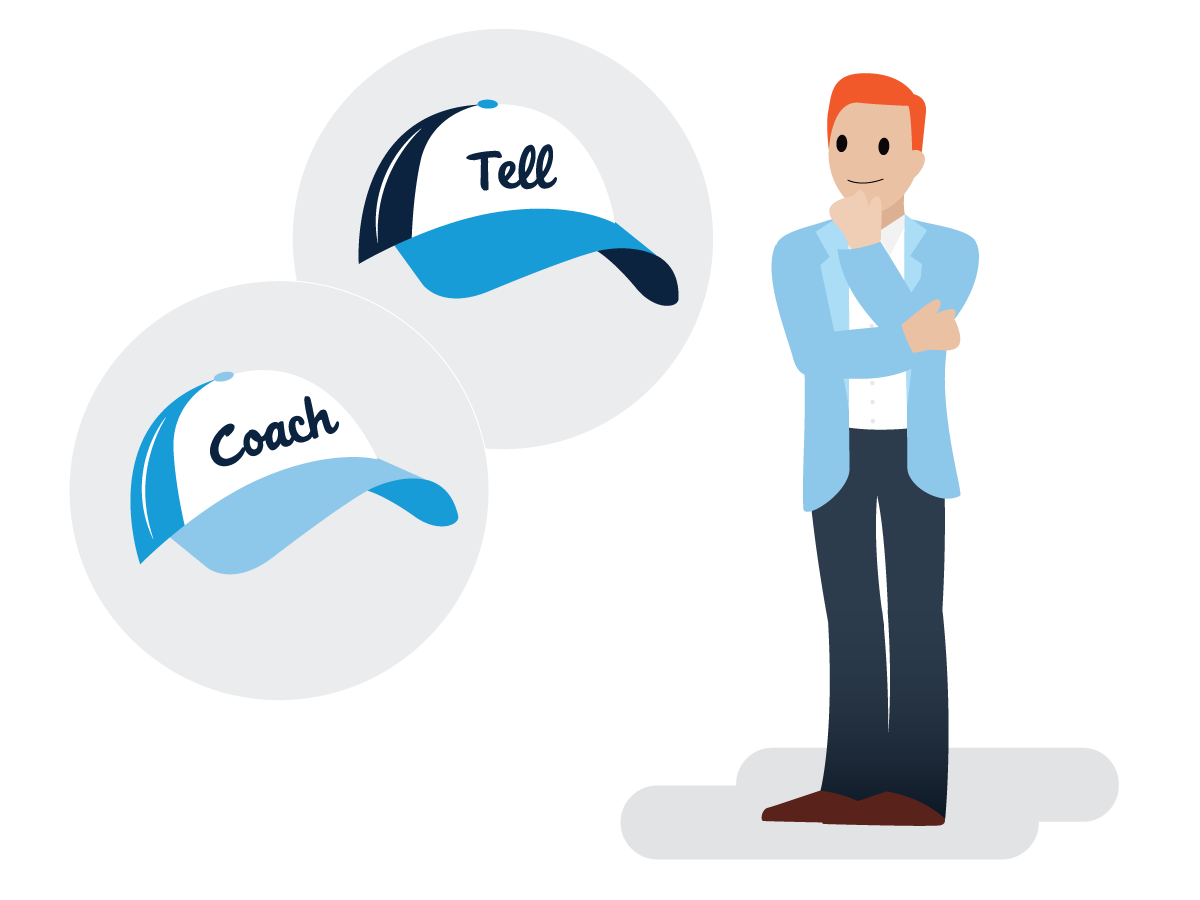Coach and Develop Others
Learning Objectives
After completing this unit, you’ll be able to:
- Identify what makes a great coach.
- Determine when to coach versus being more directive.
- Use four steps to engage in a coaching conversation.
- Ask effective coaching questions.
Understanding What Makes a Great Coach
What makes a great coach? When you’re a great coach, you inspire others and challenge them to achieve things they never thought were possible. You encourage and motivate people to do their best.
Actress and Comedian Amy Poehler has spoken to the importance of how important it is to, "Find a group of people who challenge and inspire you, spend a lot of time with them, and it will change your life."
Coaching is all about helping others learn and grow themselves. It’s not about telling someone what to do, giving advice, or solving others’ problems. It’s about helping your team discover creative solutions and overcome challenges by tapping into their own perspectives.
You also benefit from being a coach. Coaching helps you create a more capable and confident team. And your employees gain the confidence and skills to overcome challenges, improve their performance, and take charge of their careers.
Being a great coach comes down to this simple formula: Ask Great Questions + Listen Well = Great Coach.

In this unit, you’ll learn how to become a great coach. You’ll learn the difference between coaching and instructing, and when to do each one. And most importantly, you’ll get sample coaching questions that you can start using today.
Let’s get started!
Determining When to Use a Coaching or Telling Approach
To tell or not to tell? Does coaching mean that you never tell someone what to do? Does it mean that you don’t ever instruct someone on the steps to take to be successful? Nope, not at all.
Leaders wear many hats—you wear a Coaching hat as well as a Telling hat. The key is to know when to wear which hat.

Wear the “Telling” hat when:
- Someone has never done a specific task before
- The person lacks the confidence to do the task without step-by-step instructions
If you challenge people to figure it out on their own, they could feel frustrated or abandoned. They could complain to others, “Wow, my manager doesn’t support me—my manager is too hands-off.” In these instances, be more specific about what needs to be done and how to do it.
Wear the “Coaching” hat when:
- Someone already knows how to do a task
- The person is confident and excited about figuring it out independently
In this case, would you give step-by-step instructions and check in all the time? Probably not, unless you like being called a micromanager. You don’t want to get in the person’s way. In this situation, you’re coaching, encouraging, and motivating. Not telling someone what to do. When employees know what they are doing, get out of their way.
So here’s a sample of what coaching and telling sound like.
| COACH when the person... |
Try saying |
|---|---|
|
|
| TELL when the person... |
Try saying |
|---|---|
|
|
Using the Four Steps of the GROW Model to Coach
Now let’s talk about how to coach. The good news is that you don’t have to make it up. We’ll help you to coach like a pro!
Coaching is a conversation. It could be a 5-minute conversation in the hallway to talk about a challenging meeting that just took place. Or it could be a more focused, one-on-one meeting to help someone overcome an obstacle, improve performance, or drive career development.
Don’t feel that it’s always up to you to initiate the conversation. If you see someone facing a challenge, ask the person to share it with you. That’s the start of a coaching conversation. But sometimes your team members initiate the coaching by letting you know they’re facing a challenge.
What topics are appropriate for a coaching conversation? Lots.
Coaching can help your team members:
- Feel more motivated
- Perform at a higher level
- Improve relationships
- Be more effective
- Make progress in their career
- And more!
As you get better and better at coaching, people will seek you out. They’ll want to talk with you—not because you know it all, but because you’re able to help them come up with great ideas themselves.
To coach effectively, Salesforce uses a simple approach called GROW, developed by Graham Alexander, Alan Fine, and Sir John Whitmore.

GROW stands for:
- Goal
- Reality
- Options
- Will

Goal: Establish the objectives
Setting goals is the most important way to start a coaching conversation. It’s tempting to jump into giving advice or bringing up the options the person has to solve a problem. Don’t do it!
You’ve probably heard the phrase, “start with the end in mind.” This phrase is true in a coaching conversation. Start by asking what the person is trying to accomplish. It’s much easier to help someone problem-solve if you know for sure what the desired outcome looks like.
Some questions to ask in this first step:
- What are you hoping to accomplish?
- What’s your objective?
- What does success look like?

Reality: Identify what is happening
The next step is to get more information about the situation. Ask questions to help the individual get to the bottom of what’s causing the problem. This is really important!
You both might think the cause of the problem is obvious. However, there’s often a hidden answer or two about what’s driving the issue. You’re more likely to come up with the right options to solve the problem when you’re clear about what’s happening.
In this step, you’re helping your team members put on their detective hats. You’re encouraging them to look at the clues around what’s contributing to the challenge.
For example, imagine that your team member, Paul, comes to you and says, “I can’t work with that Andy in Finance anymore.” Paul might initially assume that Andy’s a jerk who can’t work with others. As you ask Paul questions, you realize that he has been inadvertently leaving Andy out of key meetings and not sharing what was going on with the project. Oops!
You can help Paul explore the situation by asking good questions, such as:
- What do you think is really going on?
- What’s driving this situation?
- Put yourself in Andy’s shoes. What do you think he feels is happening?
- What role might you play?

Options: Identify options and make choices
Here’s the step you have been waiting for—where the coaching conversation shifts into problem-solving mode.
This step is about guiding people to come up with creative ways to solve the problem or achieve the objective on their own. There might be a place at the end of the conversation to ask if the person would like your advice, but hold back from giving advice until then.
Asking questions helps someone come up with multiple options. The individual might even come up with options that neither of you would have uncovered on your own. Cool, right? When the options are on the table, the decision can be made about which actions could be taken to move forward.
Let’s continue with our example. Now that Paul understands his role in the situation with Andy, you can help him identify options to help resolve his challenge. Paul might identify ways to better involve Andy on his own. You could then ask questions to help him come up with the different actions he could take.
You might ask:
- What have you already tried? What else could you try?
- What options are there to solve this problem?
- What has worked in the past? Not worked?
- What haven’t you done that might help?

Will: Identify what will be done
This final step is critical. Coming up with creative options is worth it only if both you and your team member are willing to commit to taking specific actions.
Now that you’ve helped Paul see several ways that he can improve his situation, you can ask him to choose which actions he’ll take.
Paul might choose to:
- Meet individually with Andy to discuss the situation
- Invite him to a regular meeting to share his point of view
- Include him in the weekly update emails
You can offer your support and encouragement and set up a time to follow up.
You might ask:
- Which actions will you take? By when?
- How will you know if you are successful?
- What could get in the way? How will you address this?
- How can I help you?
Want to use GROW to get results? Watch and learn!
Asking Coaching Questions
I bet you noticed that each of the four coaching steps involves asking lots of questions. It’s not a secret that coaching is about asking the right questions. When you coach, you don’t need to have all the answers—you need to have the right questions.

Open-ended questions such as “Who?” “What?” “Where?” “When?” “How?” or “Why?” keep the conversation going and challenge the other person to think. You know you’ve asked a thought-provoking question when someone pauses and says, “That’s a great question!” If someone can answer yes or no to your question, the conversation can fizzle out before it gets started.
| Ask It This Way |
Not This Way |
|---|---|
| What’s the one thing you would change about your job? |
I bet you’d like to do more reports, right? |
| What do you like most about your job? |
You must love paperwork, huh? |
| What have you already tried? |
Have you tried doing it my way? |
| How else could you approach this? |
You didn’t do it my way, did you? |
Here are some coaching questions to get you started.
To identify issues:
- What concerns you?
- What’s getting in the way?
- What obstacles are you facing?
To generate options:
- What are your options?
- What else could you try?
- What could you do differently?
To identify new perspectives:
- What might you be overlooking?
- What’s the boldest move you could make?
- What’s the one thing you haven’t tried?
To get to the action:
- What three things will you do and by when?
- What might get in your way?
- What’s your next step?
Guess what? There are a bunch more questions to ask! It’s all about those questions.

Coaching is:
- Being curious and asking questions
- Listening carefully to what is being said and not said
- Helping others solve problems on their own
- A great way to help employees develop new skills and grow their careers
Need some tips to ask powerful coaching questions and a little GROW “cheat sheet”? Download the Coaching & Feedback pack for the Coaching Tips guide.